Burt A. The Evolution of the British Empire and Commonwealth From the American Revolution
Подождите немного. Документ загружается.


Commonwealth
Reactions
to
the
Coming
of
the Second
World
War
835
ceded.
But
the
country's
geographical
position
and
military
nakedness
made
de Valera
fearful that
its
neutrality
would not be
respected
by
the
Nazis
and,
as
a
consequence,
by
the British. He
had
great
confidence
in
Chamberlain,
arising
from
his
recent
dealings
with
him;
and
though
the
Irishman
could
not share
the cool detachment
with
which
the
Englishman
viewed the
amputation
of
territory
from
Czechoslovakia,
the
two
men
were
of one
mind
in
believing
that almost
any
peaceful
settlement
was better
than the
calamity
of
a
general
war
which
might
well
end
in
the
subjection
of all
Europe
to Russian domination.
There-
fore
de
Valera,
braving
the bitter
criticism of
many
of his
own
country-
men,
worked
in
close and continuous
cooperation
with the
British
prime
minister
throughout
the
crisis;
and
after Munich
lie went out
of
his
way
to
express
his
appreciation
of
what
Chamberlain
had done
to
preserve
the
peace.
The
South
African
government,
like
the
Canadian,
kept
its own
counsel,
but
was
prepared
to
hold aloof.
Afrikander
opinion
was so
strong
in favor of
the
Sudeten
Germans'
cry
for
annexation to
Hitler s
Reich
that
the
demand of
Malan
who had
gained
much
strength
in
the
May
election
for a
prior
declaration
of
neutrality
exerted
a
power-
ful
pull
on
Hertzog's wing
of
the United
party.
The
prime
minister
could
not
yield
to the demand
because
it meant
not
only
tearing
up
the
Simonstown
agreement
but also
splitting
the
government,
the
party,
and the nation.
On
the other
hand,
he
could not
adopt
a
policy
of
even
passive
belligerency
without
grave
risk
of
producing
the
same
fatal
split.
Therefore
he worked
out
a
compromise
formula
designed
to
shelve,
rather
than
resolve,
the
irreconcilable
differences
within the cabinet.
In
the event
of
war,
he
would
declare
that
South
African
relations
with
belligerents
would continue
as
if
there
were no
war,
that
"relations
and
obligations
between
the
Union" and
other
members of
the
common-
wealth
would
remain
unchanged
in so
far as
they
were "the
result of
contractual
obligations
concerning
the
naval
base
at
Simonstown"
or
membership
in the
League
or
"the
free association"
of commonwealth
nations,
"and
that
nobody
shall
be
permitted
to make
use
of
Union
territory
for
any
purpose
calculated
to
infringe
the said relations
and
obligations."
When
war
seemed
most
imminent,
on
the
very
day
that
Chamberlain
explained
to the
House
of
Commons
the failure
of all
his efforts to
find
a
peaceful
solution,
Hertzog
summoned
his cabinet
and
presented
his
formula
to
it.
As
he
invited
no
discussion
and
had
privately got
the
concurrence
of
Smuts
and
two
others,
the rest raised
no
objection.
He
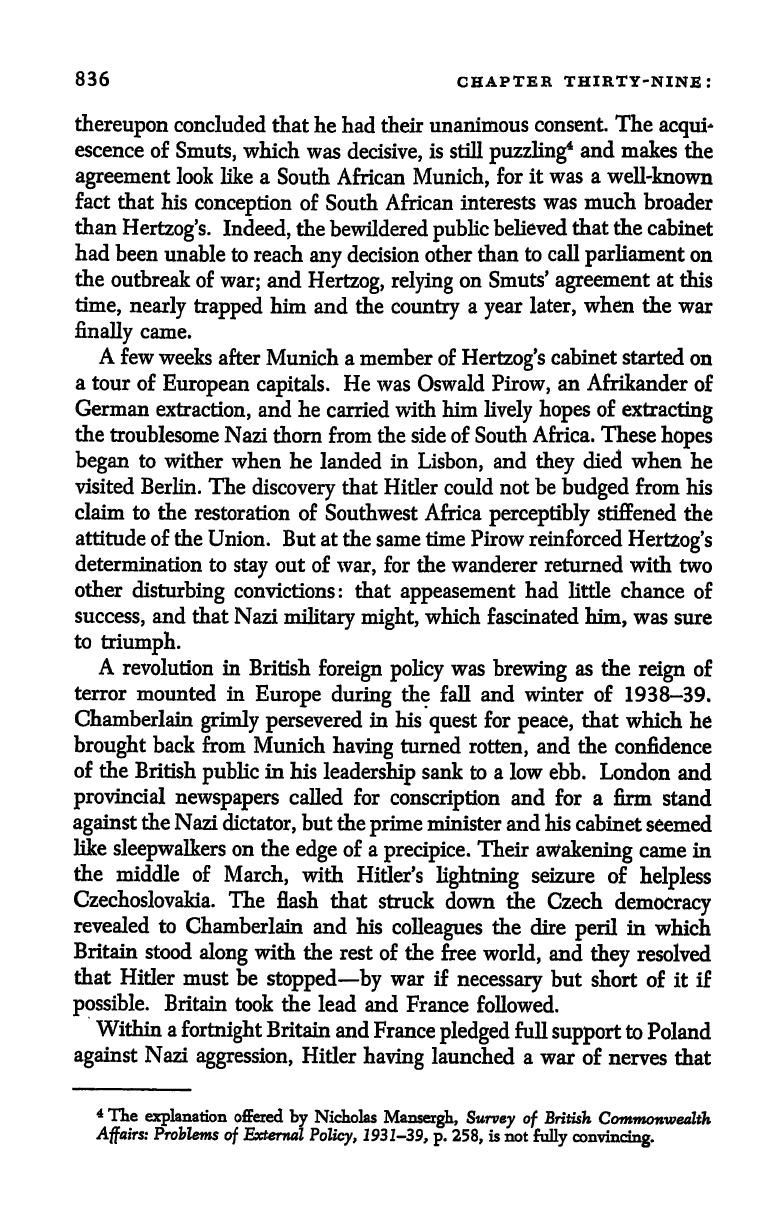
836
CHAPTER
THIRTY-NINE:
thereupon
concluded
that
he
had
their
unanimous
consent.
The
acqui*
escence
of
Smuts,
which
was
decisive,
is still
puzzling
4
and
makes
the
agreement
look like a
South African
Munich,
for
it
was a
well-known
fact
that his
conception
of
South
African
interests
was much
broader
than
Hertzog's.
Indeed,
the
bewildered
public
believed
that the
cabinet
had
been
unable to
reach
any
decision
other
than
to
call
parliament
on
the
outbreak
of
war;
and
Hertzog, relying
on Smuts'
agreement
at
this
time,
nearly
trapped
him
and
the
country
a
year
later,
when
the
war
finally
came.
A
few
weeks after
Munich a
member
of
Hertzog's
cabinet
started
on
a
tour
of
European
capitals.
He was Oswald
Pirow,
an
Afrikander
of
German
extraction,
and he
carried
with him
lively
hopes
of
extracting
the
troublesome
Nazi
thorn from
the
side
of
South
Africa.
These
hopes
began
to wither
when
he
landed
in
Lisbon,
and
they
died when
he
visited
Berlin. The
discovery
that Hitler could
not be
budged
from
his
claim to the
restoration
of
Southwest
Africa
perceptibly
stiffened
the
attitude of the
Union. But
at
the
same
time Pirow reinforced
Hertzog's
determination
to
stay
out of
war,
for
the wanderer returned with
two
other
disturbing
convictions: that
appeasement
had little
chance
of
success,
and that
Nazi
military
might,
which fascinated
him,
was sure
to
triumph.
A
revolution in
British
foreign
policy
was
brewing
as the
reign
of
terror
mounted
in
Europe
during
the fall
and
winter
of
1938-39.
Chamberlain
grimly
persevered
in his
quest
for
peace,
that
which
he
brought
back
from Munich
having
turned
rotten,
and
the
confidence
of the
British
public
in
his
leadership
sank
to
a
low ebb.
London and
provincial
newspapers
called for
conscription
and for a
firm
stand
against
the Nazi
dictator,
but the
prime
minister and his
cabinet
seemed
like
sleepwalkers
on the
edge
of a
precipice.
Their
awakening
came in
the
middle
of
March,
with
Hitler's
lightning
seizure
of
helpless
Czechoslovakia.
The
flash
that struck
down the
Czech
democracy
revealed to
Chamberlain and
his
colleagues
the dire
peril
in
which
Britain
stood
along
with
the rest
of the free
world,
and
they
resolved
that
Hitler
must be
stopped
by
war
if
necessary
but
short
of
it if
possible.
Britain
took the
lead
and
France
followed.
Within a
fortnight
Britain
and
France
pledged
full
support
to Poland
against
Nazi
aggression,
Hitler
having
launched a war
of
nerves that
4
The
explanation
offered
by
Nicholas
Mansergh,
Survey
of
British
Commonwealth
Affairs:
Problems
of
External
Policy,
1931-39,
p.
258,
is not
fully
convincing.
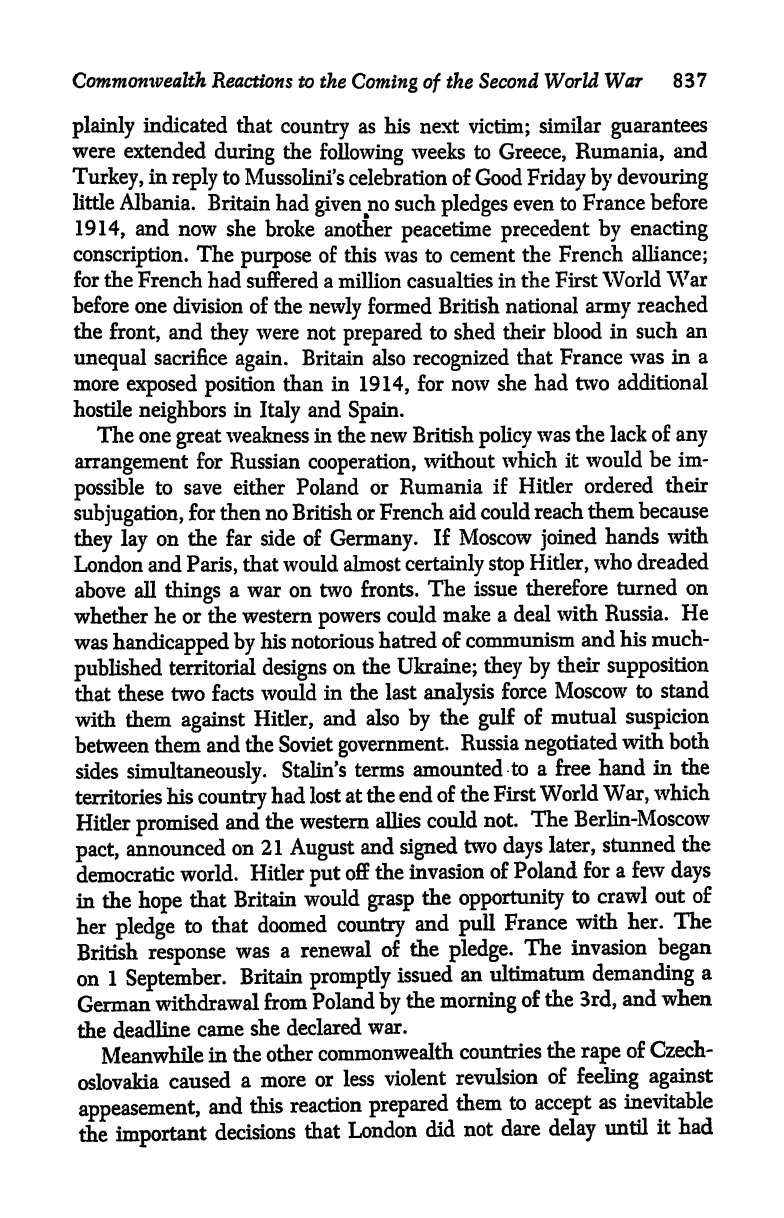
Commonwealth Reactions to
the
Coming of
the
Second
World
War
837
plainly
indicated
that
country
as
his next
victim;
similar
guarantees
were
extended
during
the
following
weeks
to
Greece,
Rumania,
and
Turkey,
in
reply
to
Mussolini's
celebration
of
Good
Friday by
devouring
little Albania.
Britain
had
given
^no
such
pledges
even
to
France
before
1914,
and
now
she
broke
another
peacetime
precedent
by
enacting
conscription.
The
purpose
of
this was
to
cement
the French
alliance;
for
the
French
had
suffered
a
million casualties
in the
First
World War
before one
division of the
newly
formed
British national
army
reached
the
front,
and
they
were
not
prepared
to
shed
their
blood
in such
an
unequal
sacrifice
again.
Britain also
recognized
that France
was in
a
more
exposed
position
than
in
1914,
for now
she
had
two
additional
hostile
neighbors
in
Italy
and
Spain.
The
one
great
weakness
in
the
new
British
policy
was the
lack
of
any
arrangement
for Russian
cooperation,
without
which it
would
be
im-
possible
to
save
either Poland
or
Rumania
if
Hitler ordered
their
subjugation,
for
then
no
British
or
French
aid
could
reach
them because
they lay
on
the far side of
Germany.
If Moscow
joined
hands
with
London
and
Paris,
that
would
almost
certainly stop
Hitler,
who
dreaded
above
all
things
a war on two
fronts.
The
issue
therefore
turned
on
whether he
or
the western
powers
could
make
a
deal
with
Russia.
He
was
handicapped
by
his notorious
hatred
of communism
and
his
much-
published
territorial
designs
on the
Ukraine;
they
by
their
supposition
that
these
two
facts
would
in the last
analysis
force
Moscow
to
stand
with
them
against
Hitler,
and
also
by
the
gulf
of
mutual
suspicion
between
them
and
the
Soviet
government.
Russia
negotiated
with both
sides
simultaneously.
Stalin's
terms
amounted
to
a free hand
in
the
territories
his
country
had
lost
at the
end
of the
First
World
War,
which
Hitler
promised
and
the
western
allies
could
not.
The
Berlin-Moscow
pact,
announced
on 21
August
and
signed
two
days
later,
stunned
the
democratic
world.
Hitler
put
off
the
invasion
of
Poland
for
a few
days
in the
hope
that
Britain
would
grasp
the
opportunity
to crawl
out of
her
pledge
to
that
doomed
country
and
pull
France
with
her.
The
British
response
was
a
renewal
of
the
pledge.
The
invasion
began
on
1
September.
Britain
promptly
issued
an
ultimatum
demanding
a
German
withdrawal
from
Poland
by
the
morning
of
the
3rd,
and
when
the
deadline
came
she
declared
war.
Meanwhile
in
the
other
commonwealth
countries
the
rape
of
Czech-
oslovakia
caused
a
more
or
less
violent
revulsion
of
feeling
against
appeasement,
and
this
reaction
prepared
them
to
accept
as
inevitable
the
important
decisions
that
London
did
not
dare
delay
until
it
had
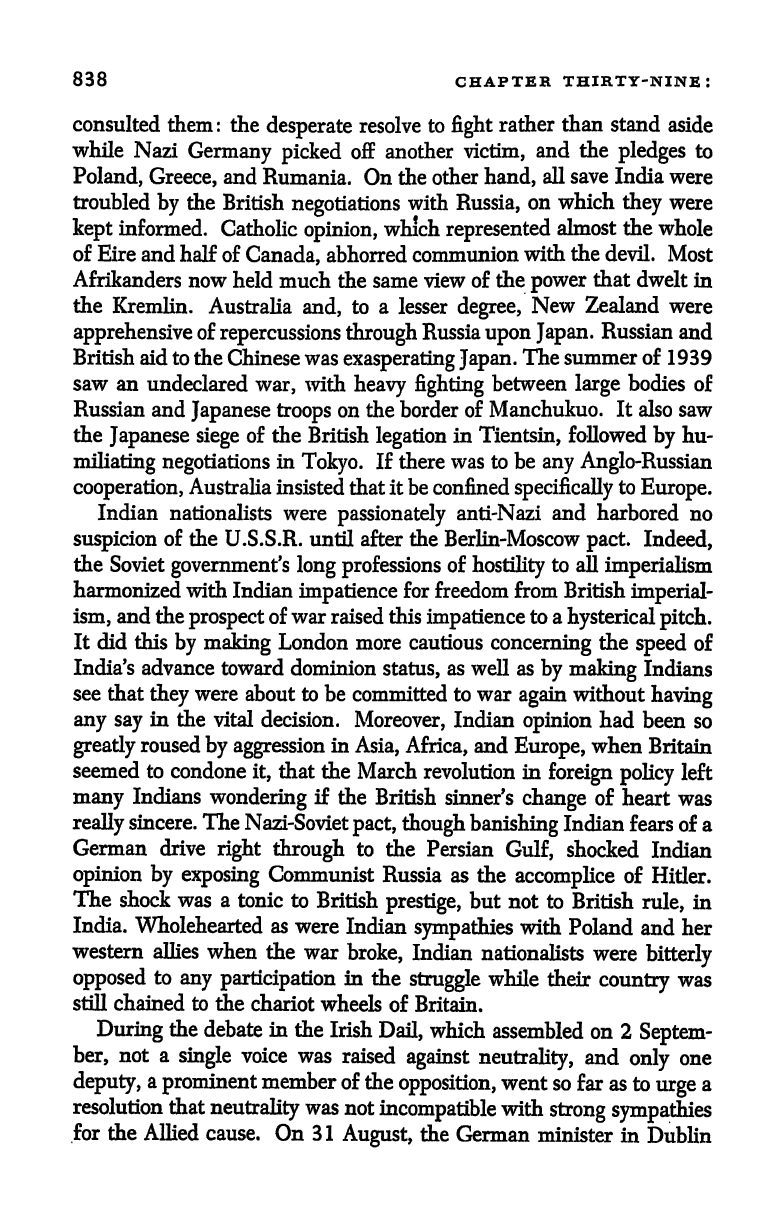
838
CHAPTER THIRTY-NINE:
consulted them:
the
desperate
resolve
to
fight
rather than stand
aside
while
Nazi
Germany
picked
off
another
victim,
and
the
pledges
to
Poland,
Greece,
and
Rumania.
On
the other
hand,
all
save
India
were
troubled
by
the
British
negotiations
with
Russia,
on
which
they
were
kept
informed.
Catholic
opinion,
which
represented
almost the
whole
of
Eire
and half of
Canada,
abhorred
communion
with
the
devil.
Most
Afrikanders now
held much the same
view of the
power
that
dwelt
in
the
Kremlin.
Australia
and,
to
a
lesser
degree,
New Zealand
were
apprehensive
of
repercussions
through
Russia
upon
Japan.
Russian
and
British
aid to the
Chinese
was
exasperating
Japan.
The summer
of
1939
saw an
undeclared
war,
with
heavy
fighting
between
large
bodies
of
Russian
and
Japanese
troops
on the border of
Manchukuo.
It
also
saw
the
Japanese
siege
of the
British
legation
in
Tientsin,
followed
by
hu-
miliating negotiations
in
Tokyo.
If
there
was
to be
any
Anglo-Russian
cooperation,
Australia
insisted that it be confined
specifically
to
Europe.
Indian
nationalists were
passionately
anti-Nazi and
harbored
no
suspicion
of the
U.S.S.R.
until
after the
Berlin-Moscow
pact.
Indeed,
the
Soviet
government's
long
professions
of
hostility
to all
imperialism
harmonized
with
Indian
impatience
for freedom from British
imperial-
ism,
and
the
prospect
of war
raised
this
impatience
to a
hysterical
pitch.
It did
this
by making
London more
cautious
concerning
the
speed
of
India's
advance toward
dominion
status,
as
well
as
by
making
Indians
see
that
they
were
about
to be committed to
war
again
without
having
any
say
in
the vital
decision.
Moreover,
Indian
opinion
had been
so
greatly
roused
by
aggression
in
Asia, Africa,
and
Europe,
when
Britain
seemed
to condone
it,
that
the
March
revolution
in
foreign policy
left
many
Indians
wondering
if the
British
sinner's
change
of
heart
was
really
sincere. The
Nazi-Soviet
pact,
though
banishing
Indian fears
of a
German drive
right
through
to die Persian
Gulf,
shocked Indian
opinion
by
exposing
Communist
Russia
as
the
accomplice
of
Hitler.
The
shock
was
a
tonic
to British
prestige,
but
not to British
rule,
in
India.
Wholehearted as
were
Indian
sympathies
with
Poland
and
her
western
allies
when
the war
broke,
Indian
nationalists
were
bitterly
opposed
to
any
participation
in
the
struggle
while their
country
was
still
chained
to
the
chariot
wheels
of Britain.
During
the
debate
in
the
Irish
Dail,
which
assembled on 2
Septem-
ber,
not a
single
voice
was
raised
against
neutrality,
and
only
one
deputy,
a
prominent
member
of
the
opposition,
went so
far as
to
urge
a
resolution that
neutrality
was
not
incompatible
with
strong
sympathies
for the
Allied
cause.
On 31
August,
the
German
minister
in
Dublin

Commonwealth
Reactions
to
the
Coming
of
the
Second
World
War
839
had
informed
de Valera that
Germany
would
respect
Eire's
neutrality
if
it were
strictly
enforced.
This
condition
inspired
doubts
of
how
it
would
affect the
country's
economic
dependence
upon
the
United
Kingdom,
which
supplied
more
than
half
Eire's
imports
and
took
all
but
two or
three
per
cent
of
its
exports.
Would
Germany
tolerate
this
trade across
the
Irish
Sea? The
ships
that
carried
it
were
British,
and
it was
supplying
Britain with essential
food.
Some
deputies
were
deeply
worried,
but not
J.
M.
Dillon,
the
opposition
member
just
mentioned.
"There
is
no more
danger
of
submarines
dominating
the Irish
Sea
than
there
is of
my going
over to
Germany
to
cut
the
mustache
of
Adolph
Hitler,"
he
said,
and
he
boldly
asserted
that
the
surrounding
sea
was
perfectly
safe "thanks
not
to
ourselves
but
thanks
to God
and
the
British
Fleet."
His
confidence
was
not
contagious.
Canada,
Australia,
and
New Zealand
were
no less
relieved
than
Eire
by
the news of
the Berlin-Moscow
pact,
though
it
unquestionably
meant
war for
them. Neither
Australia
nor
New
Zealand
issued
a declaration
of
war
against
Germany,
for
the
governments
of
both
dominions,
still
adhering
to the
principle
of undivided
sovereignty,
simply
accepted
the
British
declaration
as
binding
upon
them,
and
they
notified
London
accordingly.
When
the
New
Zealand
parliament
met
two
days
later,
the
prime
minister
asked
for
its
approval
and
the
motion
was
immedi-
ately
carried.
Australia
omitted
this
formality,
though
its
parliament
was
then
in session.
Canada
was much
more
deliberate.
On
3
1
August
the
prime
minister
announced
that
parliament
was
being
summoned
for
7
September
and
that
the
government
would
ask
it for
authority
to
cooperate
with
the
United
Kingdom.
On
the
following
day,
when the
Germans
burst
into
Poland,
he
made
it clear
that
cooperation
meant
cooperation
in
war.
Technically
the
senior
dominion
remained
neutral
until
parliament
met
and
approved
the
government's
policy,
and the
delay
allowed
vast
quantities
of
war
material
to be
rushed
in from
the
United
States.
When
parliament
came
together
the
cabinet
had not
the
slightest
doubt
of
what
the decision
would
be.
Mackenzie
Kings
great
concern
was,
by
free
and
full
debate,
to
convince
the
country
that
there
was
no
honorable
alternative
to
joining
the
side
of
freedom
and
democracy
against
"a
ruthless
and
tyrannical
power
which
seeks
world
domination."
After
two
days,
during
which
a bare
handful
opposed
the
government's
resolution
for
war,
it
was
adopted
without
a division.
South
Africa
was
the
one
dominion
that
hung
in
the
balance.
Like
Mackenzie
King,
Hertzog
was
pledged
to
get
the
consent
of
his
parlia-
ment
before
going
to
war,
but
he
resembled
de
Valera
in his
determina-

840
CHAPTER
THIRTY-NINE:
tion
to
keep
his
country
out
of
it,
and like
both
these
other
national
leaders
he was
sure that
his
policy
would
prevail.
He
honestly
believed
that
participation
in
the war
would
wreck
the
Union.
His
plan
was
not
quite
so
honest.
It was to
proclaim
neutrality
without
consulting
the
cabinet
or
parliament.
His
repeated
promises
to call
parliament
had
left
a
convenient
loophole
through
which
he could
slip.
He
had
never
promised
to
call
parliament
if
he
decided
against
war. As for the
cabi-
net,
where
he
knew he
would
face determined
opposition,
he
counted
on
acquiescence
in
a
fait
accompli
supported
by
the
pre-Munich
agreement.
A
wholly
fortuitous coincidence
upset
this
disingenuous
scheme.
In
the
middle of
August, Hertzog
found
that
he had overlooked an
impor-
tant
fact: that
the life
of
the
Senate
would
expire
on 5
September,
making
legislation impossible
for
some
time
to
come unless he
got
an
emergency
act
extending
the life of
the
Senate.
Thereupon
he
sum-
moned
parliament,
solely
for
this
purpose,
to
meet in
special
session
on
Saturday,
2
September.
When
it
assembled
on
that
date,
the
Senate
bill
was
promptly
passed,
but
there was such
public
excitement over
the
invasion
of
Poland,
the British
ultimatum,
and the
government's
strange
silence
on
what
stand South Africa
should
take,
that
the
prime
minister
had
to
promise
a
government
statement to the
House
on
Monday,
and to
consult his
cabinet
in
the
interval. That
body
met for
three
hours on
Saturday
afternoon,
and he
occupied
the
whole
time
with
a
speech
on
the
necessity
for
declaring
neutrality.
Whether
Nazi
Germany
won
or
lost,
he
said,
South
Africa
would
be
secure,
for
he
scouted
the
idea that Hitler
aimed
at
world
domination. The
meeting
was
resumed
on
Sunday
afternoon,
when Britain
was
already
at
war,
and he tried to commit
his
colleagues
by
reading
the
document
they
had
accepted
a
year
before.
Smuts
refused
to
be
bound
by
an
agreement
made
before
the Nazi menace
to the
world had become
so
clear,
and he
declared
he
would
carry
the issue
to
the
House. The
cabinet
split,
five
members
supporting
the
prime
minister
and seven
the
deputy
prime
minister.
On
the
morrow
the
opposing
leaders
of a
wrecked
government
ap-
pealed
to
the
House,
Hertzog
opening
with the
argument
that the
country
must
adopt
neutrality
for
the
sake of
national
unity,
But
before
he
sat down
he sullied
his own
cause
by
a
bold
defense
of
Hitler.
This
threw
the
advantage
to
Smuts,
who
at
once
pleaded
that
the
national
interest
and honor
called
for
participation
in the
war.
The
ensuing
debate
continued
throughout
the
day
and
on
into
the
evening.
Then

Commonwealth
Reactions to
the
Coming
of
the
Second
World
War
84
1
the
House
voted 80 to 67
in
favor
of
Smuts.
The
issue
was
not
yet
settled,
for
that
very night
the
defeated
prime
minister
went
to the
governor
general
and
asked for
a dissolution
so
that
the voters
of
the
country
could decide
the
question.
Fortunately
for
the
internal
peace
of
the
Union,
His
Excellency
was
not like
his
predecessors,
a
nobleman
sent out
from
England,
but
a
South
African,
Sir
Patrick
Duncan,
and
he
refused the
request.
Hertzog
resigned,
Smuts
became
prime
minister
with
an assured
majority
in the
House,
and
a
proclamation
of
6
Septem-
ber
severed
the
Union's
relations
with
Germany.

CHAPTER
XL
British
Participation
in
the
Second
World War
"WINSTON
is
BACK,"
the
Board of
Admiralty
signaled
to
the
fleet
on
3
September
1939.
Britain
was
already
at
war,
the
Royal
Navy
was
the
one arm
of her
services
fully
prepared
to
fight,
and the
Admi-
ralty
had
just
learned that
Churchill was
returning,
after a
quarter
of
a
century,
to take
charge
of it. The
news that
he
was back
in
the
govern-
ment,
from
which
he
had
been
excluded for
years,
and
that
he
again
occupied
this
key
post,
gave
a
much-needed
confidence to
countless
Britons
that at
last
they
would
have
resolute
leadership.
In
the
follow-
ing
spring,
when
the
Nazis
overran
Norway
and
easily
drove
out the
British
who
had
hastened to
save
that
country,
the
shock to
Britain
raised
an
angry
storm
in
the
House
of
Commons
against
Chamberlain
as
prime
minister;
and
almost
immediately
afterward the
news
that the
Nazis had attacked
neutral
Holland and
Belgium
forced his
resignation
in
favor of the
one
man
for
whom
the
whole
country
called.
Churchill
formed an
all-party
government,
which he
dominated;
and
his
inspiring
genius
made him
the
greatest
war
prime
minister
in
British
history,
the
supreme
leader of the
British
Empire
and
Commonwealth
through
more
dangerous
perils
than the
British
world had
ever
known,
and on
to final
victory.
Before
examining
the
part
that
the
British
Empire
and
Common-
wealth
played
in
World War
II,
it
will be
well to
compare
the
British
outlook
in
September
1939
with
that
of
August
1914.
The
enemy
had
bought
off
Russia;
Italy
and
Japan
were
openly
leagued
with
Germany;
and
though
both were
officially
neutral,
each
was
liable
to
strike with-
out
warning.
France
was
the
only
British
ally,
but
she
was
no
longer
the
France of 1914.
Her
position
was
more
exposed,
with a
hostile
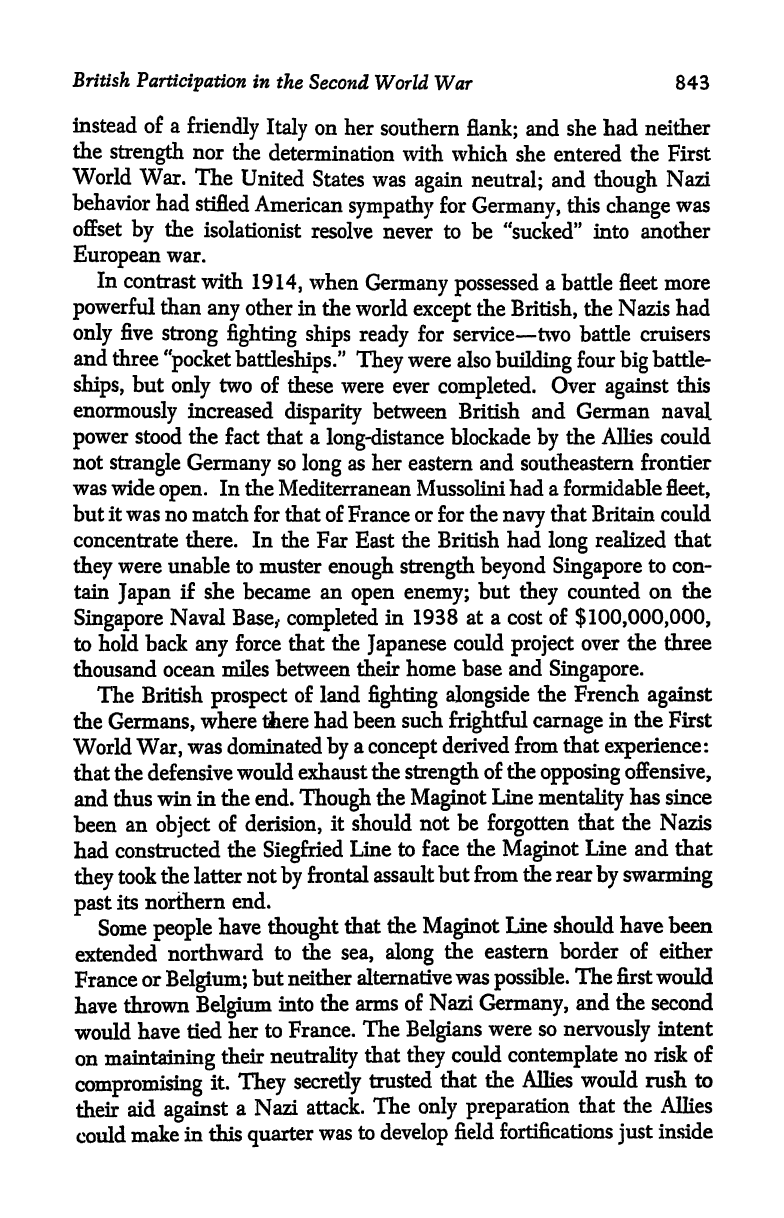
British
Participation
in
the
Second
World
War
843
instead
of a
friendly
Italy
on her
southern
flank;
and
she had
neither
the
strength
nor
the
determination with
which she entered
the
First
World
War.
The
United
States was
again
neutral;
and
though
Nazi
behavior
had
stifled
American
sympathy
for
Germany,
this
change
was
offset
by
the
isolationist
resolve
never
to
be "sucked"
into
another
European
war.
In
contrast
with
1914,
when
Germany
possessed
a battle fleet
more
powerful
than
any
other
in
the
world
except
the
British,
the Nazis
had
only
five
strong
fighting
ships
ready
for service two
battle
cruisers
and
three
"pocket
battleships."
They
were
also
building
four
big
battle-
ships,
but
only
two
of these
were
ever
completed.
Over
against
this
enormously
increased
disparity
between British and German
naval,
power
stood the
fact that a
long-distance
blockade
by
the Allies
could
not
strangle Germany
so
long
as
her
eastern
and southeastern
frontier
was
wide
open.
In the
Mediterranean
Mussolini had
a
formidable
fleet,
but
it
was
no match for that of
France
or
for
the
navy
that Britain could
concentrate there. In the
Far
East
the
British
had
long
realized
that
they
were
unable to
muster
enough
strength
beyond Singapore
to
con-
tain
Japan
if
she became
an
open
enemy;
but
they
counted
on
the
Singapore
Naval
Base,
completed
in
1938
at a
cost of
$100,000,000,
to hold
back
any
force
that
the
Japanese
could
project
over the three
thousand
ocean
miles between
their
home base
and
Singapore.
The British
prospect
of land
fighting
alongside
the
French
against
the
Germans,
where
tihere had been
such
frightful carnage
in the
First
World
War,
was dominated
by
a
concept
derived from
that
experience:
that
the defensive
would
exhaust
the
strength
of
the
opposing
offensive,
and
thus
win in the end.
Though
the
Maginot
Line
mentality
has
since
been
an
object
of
derision,
it should
not be
forgotten
that
the Nazis
had
constructed
the
Siegfried
Line to
face
the
Maginot
Line
and that
they
took
the
latter
not
by
frontal
assault
but
from
the rear
by
swarming
past
its
northern
end.
Some
people
have
thought
that
the
Maginot
Line should
have
been
extended
northward
to
the
sea,
along
the
eastern border of either
France
or
Belgium;
but
neither
alternative
was
possible.
The
first
would
have
thrown
Belgium
into
the
arms of
Nazi
Germany,
and
the
second
would
have
tied
her
to
France.
The
Belgians
were
so
nervously
intent
on
maintaining
their
neutrality
that
they
could
contemplate
no
risk of
compromising
it.
They
secretly
trusted
that the Allies would rush
to
their
aid
against
a Nazi
attack.
The
only
preparation
that the
Allies
could
make
in
this
quarter
was
to
develop
field
fortifications
just
inside
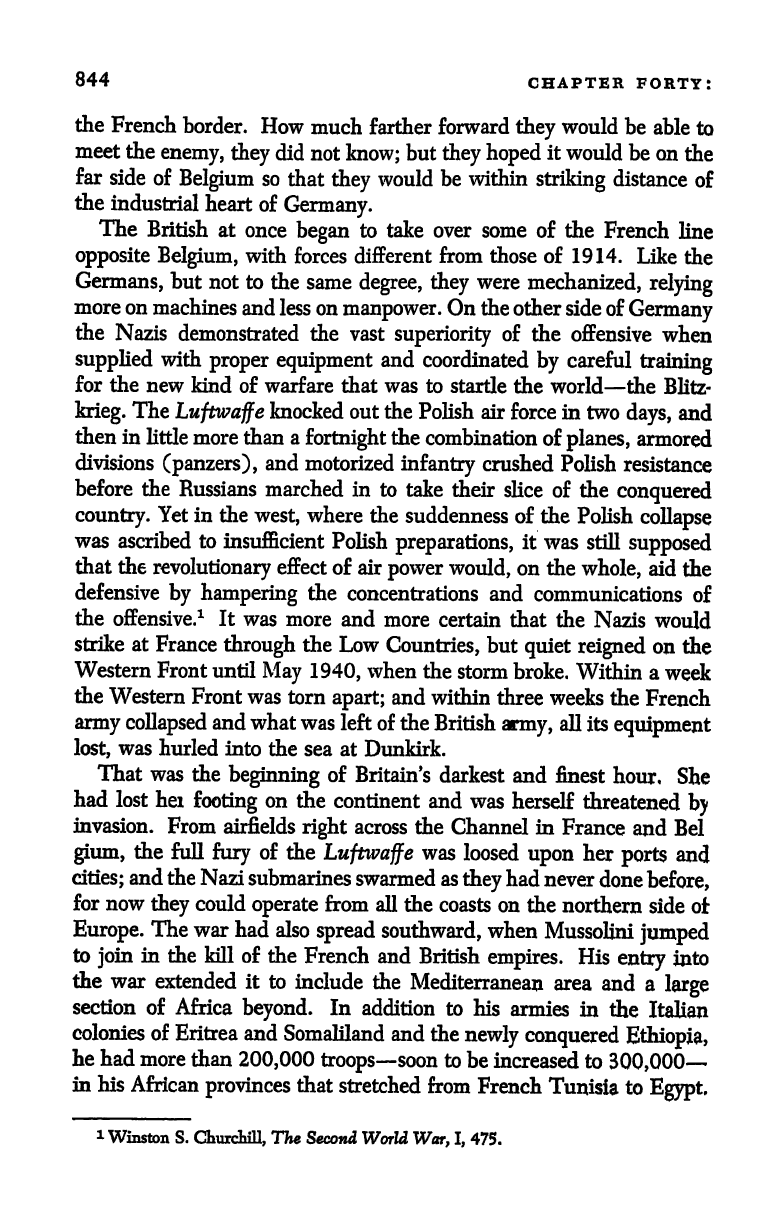
844
CHAPTER
FORTY:
the
French
border.
How
much farther forward
they
would
be
able
to
meet
the
enemy,
they
did
not
know;
but
they hoped
it
would be
on
the
far
side
of
Belgium
so
that
they
would be
within
striking
distance
of
the
industrial
heart
of
Germany.
The
British at
once
began
to
take over some
of
the
French
line
opposite
Belgium,
with
forces different
from
those
of
1914.
Like
the
Germans,
but
not
to
the same
degree, they
were
mechanized,
relying
more
on
machines
and less on
manpower.
On the other
side of
Germany
the
Nazis
demonstrated the vast
superiority
of the
offensive
when
supplied
with
proper equipment
and
coordinated
by
careful
training
for the
new
kind of warfare that was
to
startle
the world
the
Blitz-
krieg.
The
Luftwaffe
knocked out the
Polish air
force in
two
days,
and
then
in
little more than
a
fortnight
the
combination
of
planes,
armored
divisions
(panzers),
and
motorized
infantry
crushed Polish
resistance
before the
Russians
marched in
to
take
their
slice
of
the
conquered
country.
Yet
in
the
west,
where the
suddenness
of the
Polish
collapse
was
ascribed to
insufficient
Polish
preparations,
it was still
supposed
that the
revolutionary
effect of air
power
would,
on
the
whole,
aid
the
defensive
by
hampering
the
concentrations
and
communications
of
the
offensive.
1
It
was more
and more
certain that
the
Nazis
would
strike at
France
through
the
Low
Countries,
but
quiet
reigned
on
the
Western
Front until
May
1940,
when
the storm
broke.
Within a
week
the
Western
Front was
torn
apart;
and
within
three weeks
the
French
army
collapsed
and
what
was left
of the British
army,
all
its
equipment
lost,
was
hurled
into the sea
at Dunkirk.
That
was the
beginning
of
Britain's darkest
and
finest
hour.
She
had lost
hei
footing
on
the
continent
and was
herself
threatened
by
invasion.
From
airfields
right
across the
Channel in
France
and
Bel
gium,
the
full
fury
of
the
Luftwaffe
was
loosed
upon
her
ports
and
cities;
and the Nazi
submarines swarmed as
they
had never
done
before,
for
now
they
could
operate
from
all the
coasts
on the
northern side
ot
Europe.
The war
had
also
spread
southward,
when
Mussolini
jumped
to
join
in the
kill of the
French
and
British
empires.
His
entry
into
the
war
extended it
to
include
the
Mediterranean
area
and a
large
section
of
Africa
beyond.
In
addition
to
his
armies
in
the
Italian
colonies
of Eritrea
and
Soinaliland
and the
newly
conquered
Ethiopia,
he
had more
than
200,000
troops
soon
to be
increased
to
300,000
in his
African
provinces
that
stretched
from
French
Tunisia
to
Egypt.
i
Winston S.
Churchill,
The Second
World
War, I,
475.
